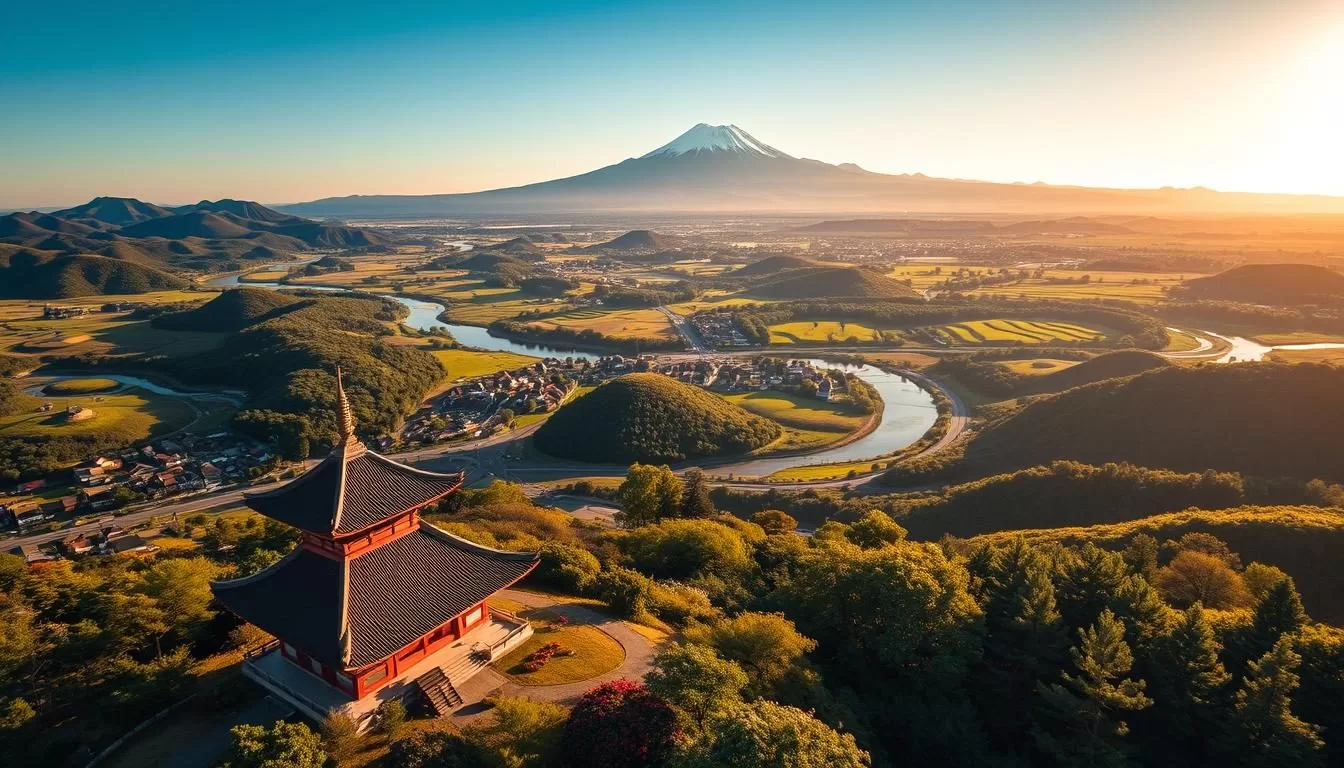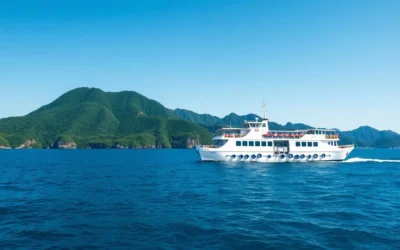✓ Tours & Activities ✓ Tours & Activities
Are you looking for a destination that offers a mix of natural beauty, history, and culture? Look no further than Kyūshū, Japan’s third-largest island. This region is a treasure trove of experiences, from active volcanoes to historic cities and rejuvenating hot springs.
As a place that’s often overlooked by tourists flocking to Tokyo and Kyoto, Kyūshū provides an authentic experience for visitors seeking to explore beyond Japan’s popular cities. With so many things to see and do, it’s an ideal destination for travelers looking to immerse themselves in the local culture and natural beauty of southern Japan over the year.
Discovering Kyushu: Japan’s Volcanic Southern Island
Located at the southwestern tip of Japan, Kyushu is a treasure trove of natural wonders and cultural heritage. As the third-largest island in Japan, Kyushu is a significant part of the country’s identity.
Where is Kyushu Located?
Kyushu is situated at the southwestern end of Japan, separated from the main island, Honshu, by a narrow strait. Despite being separated, Kyushu is connected to Honshu via tunnels and bridges, making it easily accessible. The region comprises seven prefectures: Fukuoka, Saga, Nagasaki, Kumamoto, Oita, Miyazaki, and Kagoshima, each offering distinct cultural and natural attractions.
| Prefecture | Main Attractions |
|---|---|
| Fukuoka | Hakata District, Canal City, Dazaifu Tenmangu Shrine |
| Nagasaki | Nagasaki Peace Park, Dejima, Gunkanjima |
| Kumamoto | Kumamoto Castle, Suizenji Garden |
What Makes Kyushu Special
Kyushu’s unique blend of natural beauty and cultural heritage makes it a standout part of Japan. The island’s volcanic landscape has shaped its geography and culture, creating a region famous for its hot springs, dramatic mountains, and fertile agricultural lands. Historically, Kyushu’s strategic location made it Japan’s gateway to the rest of Asia, resulting in a unique cultural blend visible in its architecture, cuisine, and traditions.
The special appeal of Kyushu comes from its combination of accessible wilderness, preserved historical sites, and the warm hospitality of locals who maintain traditional ways of life. The area experiences a subtropical climate, making it generally warmer than other parts of Japan and allowing for year-round travel with different seasonal highlights. As a significant part of Japan’s cultural and natural landscape, Kyushu is a microcosm of the country‘s diversity, offering something for every kind of traveler. Its unique charm has made it a beloved destination, attracting visitors from around the world.
How to Get to Kyushu Island
Getting to Kyushu Island is easier than you think, with multiple transportation options available. Whether you’re coming from within Japan or from abroad, you can choose the method that best suits your travel plans.
Flying to Kyushu
Flying is often the most time-efficient way to reach Kyushu, especially from Tokyo. With flights to Fukuoka (FUK), Nagasaki (NGS), Kumamoto (KMJ), Kagoshima (KOJ), and Miyazaki (KMI) airports, you can land in various parts of the island. The flight time from Tokyo is approximately 2 hours, making it a quick and convenient option.
Upon arrival, you’ll find that these airports are well-connected to the city centers, allowing for easy onward travel. For instance, Fukuoka Airport is linked to the city center by a subway line, making it simple to reach your final destination.
Taking the Shinkansen (Bullet Train)
For those already in Japan, taking the Shinkansen, or bullet train, is a popular option. The Kyushu Shinkansen line connects Fukuoka to Kagoshima, while the Sanyo Shinkansen links Fukuoka to Osaka and beyond. You can travel from Osaka to Fukuoka in about 2 hours and 30 minutes, and from Tokyo, the journey takes around 5-6 hours with a transfer at a major train station like Shin-Osaka.
The Shinkansen is particularly convenient for travelers coming from Hiroshima, taking just over an hour to reach Fukuoka. This makes it feasible to visit Kyushu as a day trip from western Honshu. Moreover, international visitors with a Japan Rail Pass can use it for the Shinkansen journey to and within Kyushu, offering excellent value for those planning to explore multiple destinations on the island.
Best Time to Visit Kyushu Island
Kyushu Island, with its diverse climate and activities, is a year-round destination, but knowing when to go can enhance your experience. The island enjoys a milder climate than much of Japan, making it an attractive location for visitors throughout the year.
Seasonal Highlights
Each season in Kyushu offers unique experiences. In the spring (March to May), cherry blossoms bloom in late March to early April, creating stunning scenery at sites like Kumamoto Castle and Maizuru Park in Fukuoka. Spring is arguably the most popular time to visit, attracting many visitors.
During the summer (June to August), warm temperatures and occasional rain characterize the weather, but it’s also the season for festivals. Events like the Hakata Gion Yamakasa in Fukuoka (July) draw visitors from across Japan, making it a vibrant time to experience the local culture.
In the fall (September to November), Kyushu’s mountains are transformed with vibrant autumn colors, particularly spectacular in areas like Mount Aso and Kirishima. The comfortable temperatures make it an ideal time for hiking and outdoor activities, extending your stay into more days.
Winter (December to February) is mild compared to northern Japan, with temperatures rarely dropping below freezing in coastal areas. This makes it an excellent time to enjoy Kyushu’s famous hot springs without the crowds, making your days relaxing.
Weather Considerations
While Kyushu is a year-round destination, there are weather considerations to keep in mind. The rainy season typically occurs from early June to mid-July, and typhoon season peaks in August and September. Travelers during these times should build flexibility into their itineraries to make the most of their visit to the island.
Getting Around Kyushu Island
To experience all that Kyushu has to offer, you’ll need to know your transportation options. The island provides multiple ways to get around, catering to different travel styles and itineraries.
Renting a Car in Kyushu
Renting a car in Kyushu gives you the flexibility to explore the island at your own pace, especially when visiting natural attractions like Takachiho Gorge and Mount Aso, which have limited public transport access. International visitors will need to obtain an International Driving Permit before arriving in Japan.
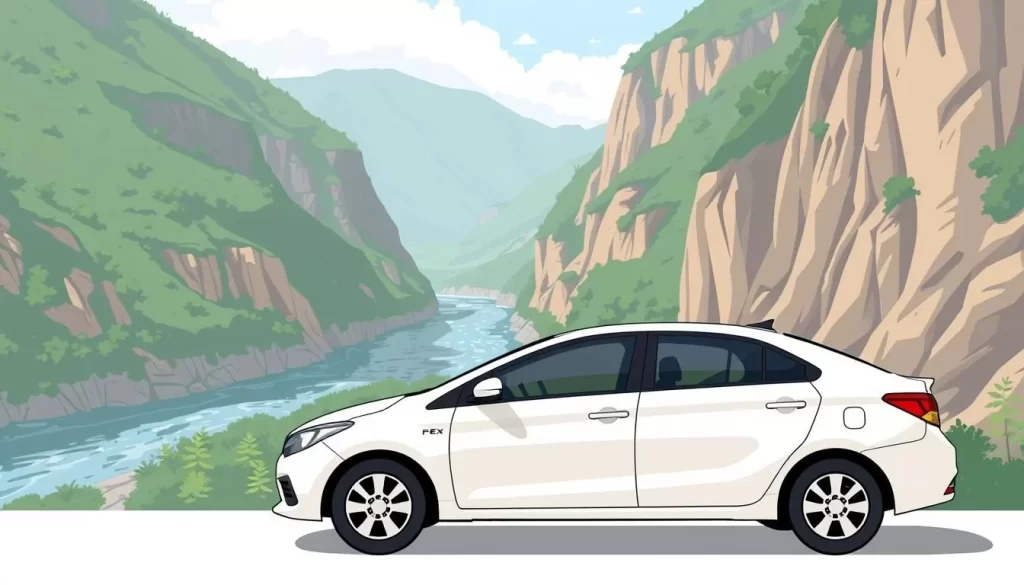
Public Transportation Options
The Kyushu Shinkansen train runs from Fukuoka to Kagoshima, connecting major cities quickly and comfortably. Local JR lines and private railways cover most populated areas, while bus networks fill the gaps, connecting major cities and serving rural areas and tourist sites.
The Kyushu Rail Pass
The Kyushu Rail Pass offers unlimited travel on JR trains, including the Kyushu Shinkansen, for 3, 5, or 7 days. This pass provides excellent value for visitors planning to explore multiple areas of the island. For urban exploration, cities like Fukuoka, Nagasaki, and Kumamoto have efficient city transportation systems, including trams, buses, and subway lines.
In conclusion, whether you’re traveling by car or using public transport, Kyushu is relatively easy to navigate. Planning your transportation in advance will help you make the most of your trip and enjoy all that the island has to offer in the most convenient way possible.
Fukuoka: Gateway to Kyushu
Fukuoka serves as the primary gateway to Kyushu, offering a blend of traditional and modern experiences. As the largest city on the island, it provides an ideal introduction to Kyushu’s culture, cuisine, and urban energy. Visitors can explore various aspects of Fukuoka during their day trip or stay.
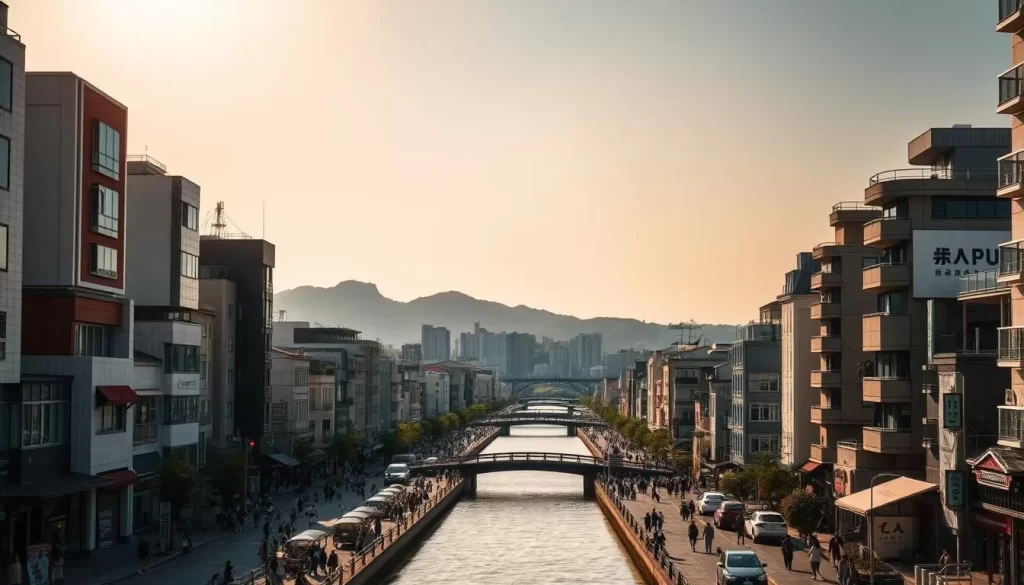
Hakata District and Canal City
The Hakata district, surrounding Hakata Station, is the commercial heart of Fukuoka, featuring shopping complexes, restaurants, and entertainment venues. This bustling area showcases modern Japanese urban life. You can spend a leisurely time exploring the local shops and eateries.
Canal City Hakata is a massive shopping and entertainment complex with its own canal running through it. It houses over 250 shops, cafes, restaurants, and a “Ramen Stadium” featuring regional ramen styles from across Japan, making it a must-visit place in Fukuoka.
Fukuoka’s Famous Food Scene
Fukuoka is renowned throughout Japan for its food culture, particularly its tonkotsu ramen and fresh seafood from the nearby coast. Every year, food enthusiasts visit Fukuoka to experience its culinary delights. The city’s yatai (food stalls) along the riverside are a highlight, offering a unique dining experience in the evening.
Dazaifu Tenmangu Shrine
Located about 30 minutes from central Fukuoka, Dazaifu Tenmangu Shrine is one of Japan’s most important Shinto shrines, dedicated to the deity of learning. The shrine features beautiful architecture and approximately 6,000 plum trees that bloom spectacularly in early spring, making it a serene and culturally significant destination.
Nagasaki: History and Cultural Fusion
The city of Nagasaki is a testament to Japan’s complex past and its cultural exchange with the world. As you explore Nagasaki, you’ll uncover a rich tapestry of history, from the tragic events of the atomic bombing to its role as Japan’s window to the Western world during its period of isolation.
Nagasaki’s unique history has made it a significant cultural and historical place in Japan. The city’s resilience and commitment to peace are evident in its various landmarks and cultural practices.
Nagasaki Peace Park and Atomic Bomb Museum
The Nagasaki Peace Park and Atomic Bomb Museum provide a moving and educational experience about the August 9, 1945, bombing, its aftermath, and the city’s commitment to peace and nuclear disarmament. Visitors can pay their respects at the park and gain a deeper understanding of the events that shaped the city.
| Location | Description |
|---|---|
| Nagasaki Peace Park | A memorial park dedicated to the atomic bombing |
| Atomic Bomb Museum | A museum showcasing the history of the bombing and its impact |
Dejima and Dutch Influences
Dejima, a fan-shaped artificial island in Nagasaki harbor, was Japan’s only point of contact with European traders during the Edo Period’s isolation policy. Today, it features reconstructed buildings that showcase this fascinating cultural exchange.
Gunkanjima (Battleship Island)
Gunkanjima, an abandoned coal mining facility located offshore from Nagasaki, offers visitors a haunting glimpse into Japan’s industrial past. This place has gained fame as a filming location for movies, including the James Bond film “Skyfall.” Every year, many visitors come to see this unique island.
As you explore Nagasaki, you’ll find that the city’s cosmopolitan heritage is evident in its architecture, cuisine, and festivals. The blend of cultures is a result of its historical significance and cultural exchange over time.
Kumamoto: Home to Japan’s Famous Castle
Kumamoto Castle is the crown jewel of Kumamoto City, making it an unmissable stop on your Kyushu adventure. As one of Japan’s three premier castles, alongside Himeji and Matsumoto, it stands out as a must-visit destination for history enthusiasts. The city’s rich history and cultural significance are deeply intertwined with the castle’s presence.
Exploring Kumamoto Castle
Kumamoto Castle, originally built in the early 17th century, boasts impressive stone walls, multiple turrets, and a reconstructed main keep that houses a museum about the castle’s history and samurai culture. The castle’s architecture is a testament to Japan’s feudal past, offering visitors a glimpse into the country’s rich heritage. Although the castle suffered significant damage during the 2016 earthquake, the main keep has been repaired and reopened to visitors. However, restoration work on other parts of the complex is ongoing and expected to continue for many years.
One of the castle’s highlights is its beautiful surroundings. Around 800 cherry trees surround the castle grounds, making it one of Kyushu’s most popular cherry blossom viewing spots in late March to early April each year. This natural beauty, combined with the castle’s historical significance, makes it a unique destination.
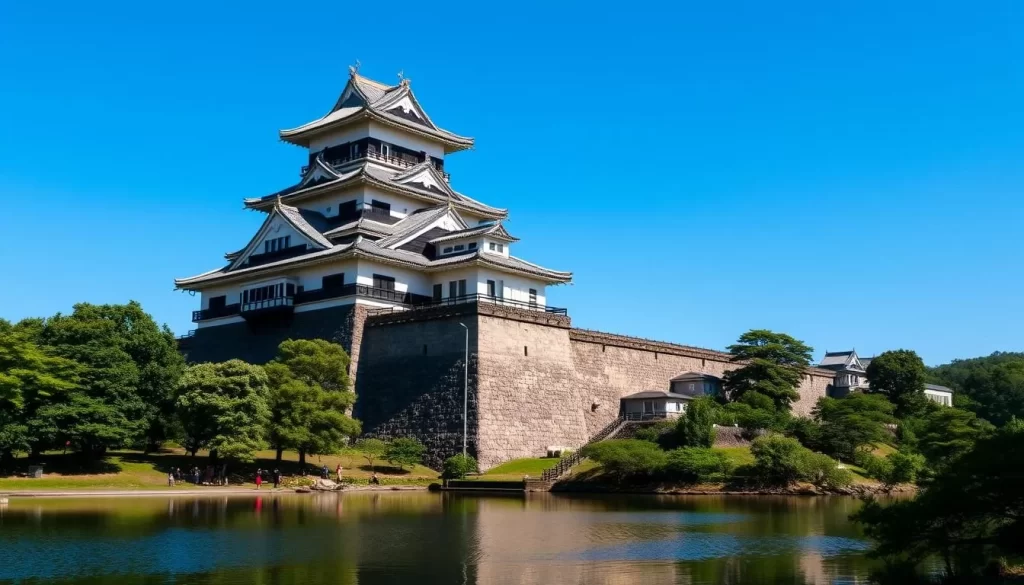
Suizenji Garden
In addition to the castle, Kumamoto City is home to the serene Suizenji Garden, a traditional Japanese landscape garden created in the 17th century. This garden replicates in miniature the 53 post stations of the old Tokaido road that connected Edo (Tokyo) to Kyoto, complete with a small-scale representation of Mount Fuji. It’s a tranquil oasis that offers a different perspective on Japanese culture and history.
| Attraction | Description | Best Time to Visit |
|---|---|---|
| Kumamoto Castle | Historic castle with impressive stone walls and a museum | Late March to early April for cherry blossoms |
| Suizenji Garden | Traditional Japanese landscape garden with miniature Tokaido road | Anytime, but best during spring or autumn |
Kumamoto City serves as an excellent base for exploring central Kyushu, with easy access to Mount Aso, Takachiho Gorge, and other natural attractions in the region. Whether you’re interested in history, nature, or culture, Kumamoto has something to offer, making it a great addition to your Kyushu itinerary.
Mount Aso: Japan’s Largest Active Volcano
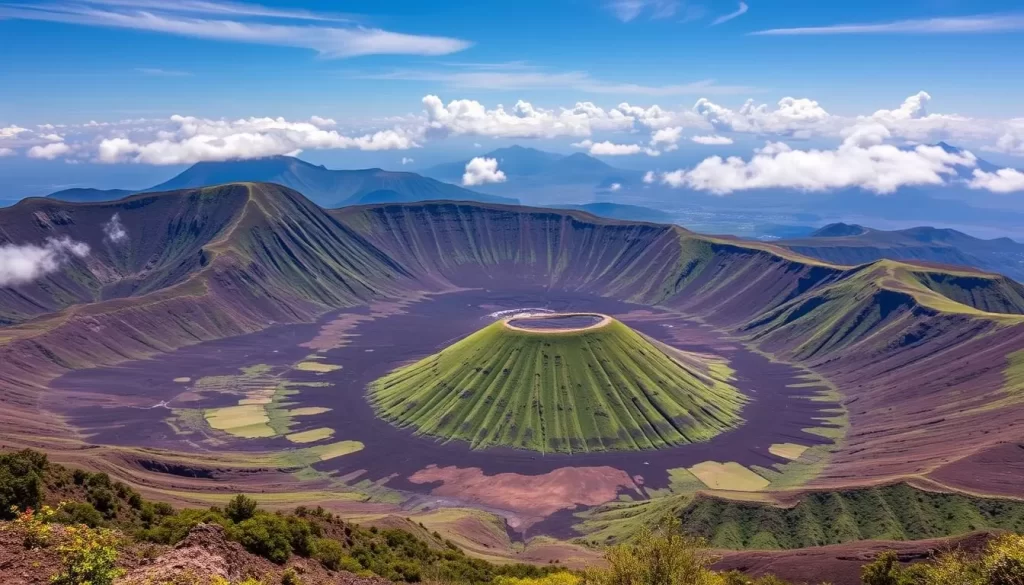
The majestic Mount Aso, situated within Aso-Kuju National Park, is a testament to Kyushu’s natural beauty and volcanic activity. As you explore this region, you’ll discover a vast caldera, approximately 25 kilometers north to south and 18 kilometers east to west, housing five distinct peaks known as the Aso Five Mountains.
Hiking Mount Aso
Hiking opportunities abound in the Mount Aso region, with trails of varying difficulty that lead to different peaks and offer spectacular views of the volcanic landscape, grasslands, and surrounding countryside. You can hike to the summit of Mount Naka, the most active of the Aso Five Mountains, or explore other trails that provide unique perspectives on this volcanic area.
The trails in Mount Aso area cater to different skill levels, ensuring that whether you’re a seasoned hiker or just starting out, there’s a path for you to enjoy the natural beauty of this region.
Safety Tips for Visiting an Active Volcano
Safety is paramount when visiting Mount Aso, as volcanic activity can change rapidly. You should always check current conditions with the Japan Meteorological Agency before heading out and follow all posted warnings. Be prepared for sudden closures of trails and access roads, and stay informed to ensure a safe and enjoyable visit.
By being aware of the potential hazards and taking necessary precautions, you can have a safe and memorable experience exploring Mount Aso.
Takachiho Gorge: Mythical Beauty
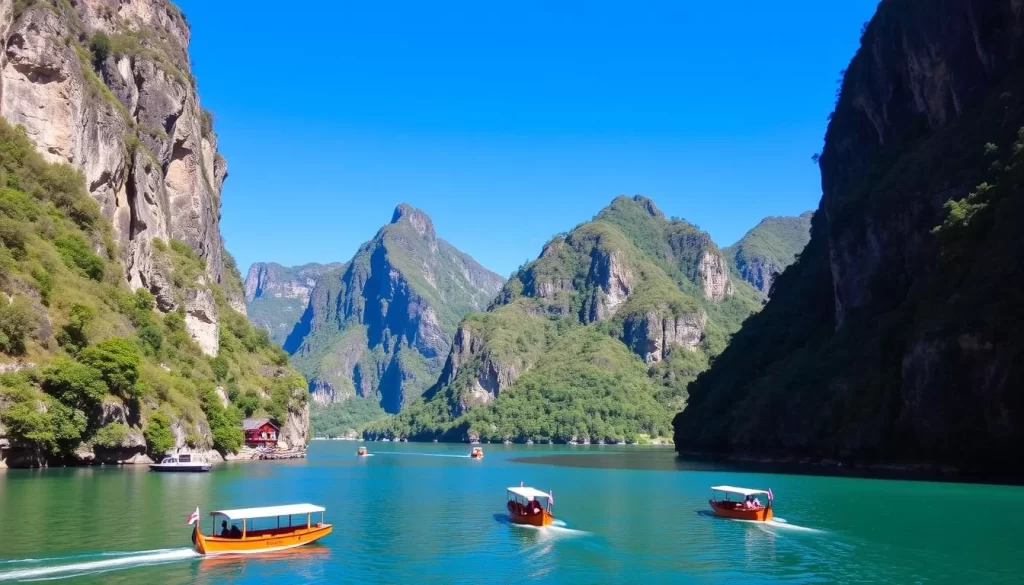
In the serene landscapes of Miyazaki Prefecture lies Takachiho Gorge, a place where nature’s beauty and ancient myths entwine. This breathtaking natural wonder is characterized by the Gokase River, which has carved through volcanic basalt columns to create a narrow chasm of extraordinary beauty.
One of the highlights of visiting Takachiho Gorge is the opportunity to rent a rowboat and paddle through the gorge. As you row, you’ll be surrounded by towering 100-meter cliffs lined with lush trees and vegetation, and you’ll witness the dramatic 17-meter high Minainotaki Waterfall cascading into the emerald water below.
Rowing Through the Gorge
Rowing through Takachiho Gorge is an experience that combines adventure with serene natural beauty. As you glide across the water, you’ll have the chance to appreciate the gorge’s unique geological formations and the vibrant ecosystem that thrives within this secluded place. The tranquility of the gorge makes it an ideal spot to spend a relaxing day.
Takachiho Shrine and Night Kagura Performances
Beyond its natural splendor, Takachiho Gorge holds profound significance in Japanese mythology. The nearby Takachiho Shrine, set amidst ancient cedar trees, hosts nightly Yokagura performances—sacred dances that reenact the mythological stories associated with the area. Visitors can gain insight into Japan’s ancient Shinto traditions by attending one of these performances, making their visit a memorable experience at this sacred place.
To fully experience Takachiho Gorge, plan your visit according to the season. Spring brings fresh greenery, summer offers coolness by the water, autumn transforms the surrounding trees with vibrant colors, and winter provides a serene atmosphere with fewer visitors. Whether you hike along the riverside paths or simply enjoy the views, Takachiho Gorge is a destination that promises an unforgettable experience.
Kyūshū Island, Japan: Best Things to Do – Top Picks for Nature Lovers
With its unique blend of volcanic landscapes, ancient forests, and stunning coastlines, Kyushu is a must-visit destination for nature lovers. The island offers a diverse range of outdoor activities and breathtaking natural beauty.
Kirishima Mountain Range
The Kirishima Mountain Range, located within Kirishima-Kinkowan National Park, is a haven for hikers and nature enthusiasts. The range offers trails that wind past active volcanoes and crater lakes, with spectacular views of the surrounding landscape. You can hike to the summit of Mount Karakuni, the highest peak in the range at 1,700 meters, and enjoy the alpine meadows filled with seasonal wildflowers.
Yakushima Island’s Ancient Forests
Yakushima Island, a UNESCO World Heritage site, is home to ancient cedar forests with trees over 1,000 years old. The island’s hiking trails range from easy walks to challenging multi-day treks, including the famous route to Jomon Sugi, a cedar estimated to be between 2,000 and 7,200 years old. The primeval forests of Yakushima inspired the mystical forest scenes in Studio Ghibli’s film “Princess Mononoke.”
Stunning Waterfalls of Kyushu
Kyushu is home to numerous stunning waterfalls, each with its unique charm. You can visit Nabegataki Falls in Kumamoto Prefecture, where you can walk behind the cascading water, or Manai Falls in Takachiho, which features prominently in Japanese mythology. These waterfalls offer a serene and picturesque experience, surrounded by lush vegetation and natural beauty.
| Location | Attraction | Activity |
|---|---|---|
| Kirishima Mountain Range | Mount Karakuni | Hiking |
| Yakushima Island | Jomon Sugi | Trekking |
| Kumamoto Prefecture | Nabegataki Falls | Waterfall Viewing |
Onsen Experience: Kyushu’s Famous Hot Springs
As Japan’s premier hot spring destination, Kyushu offers a unique onsen experience. With its volcanic landscape, the island is home to thousands of natural hot springs, ranging from simple public facilities to luxurious resort spas.
Beppu: Japan’s Hot Spring Capital
Beppu, located in Oita Prefecture, is known as Japan’s hot spring capital. It produces more hot spring water than any other city in the country, boasting over 2,000 hot spring vents and eight major hot spring areas known as the “Beppu Hatto” (Eight Beppu Hot Springs).
The “Hells of Beppu” (Jigoku) are a series of seven spectacular hot springs for viewing rather than bathing, each with unique characteristics such as the cobalt blue water of Umi Jigoku (Sea Hell) or the bubbling mud of Oniishibozu Jigoku.
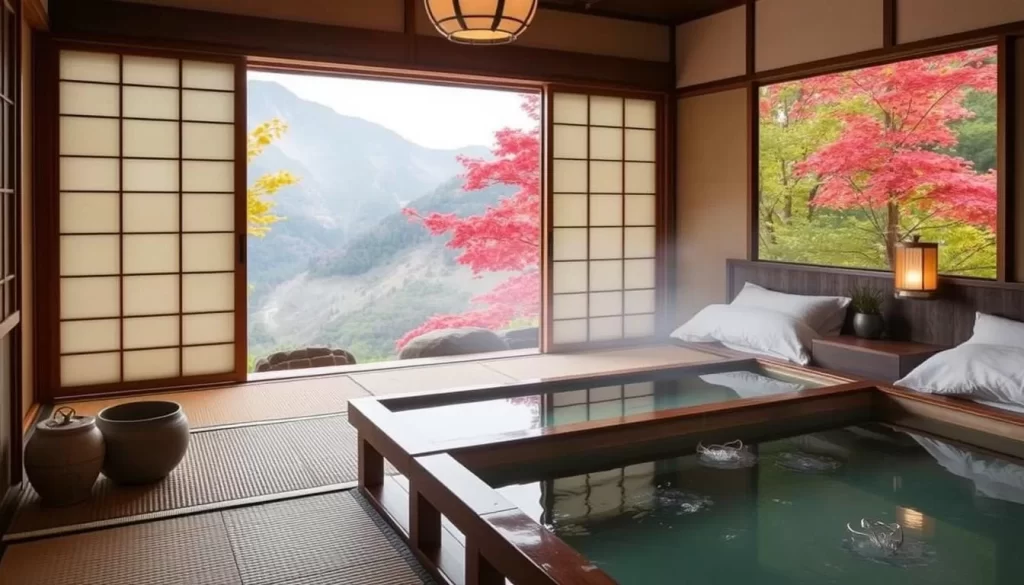
Kurokawa Onsen: Traditional Hot Spring Town
Nestled in a forested valley in central Kyushu, Kurokawa Onsen offers a traditional and intimate hot spring experience. This charming town is home to numerous ryokan (traditional inns) featuring both indoor and outdoor baths in natural settings.
Onsen Etiquette for First-Timers
If you’re new to onsen, it’s essential to understand the etiquette. Before entering the bath, wash your body thoroughly. Never bring towels into the water, and be aware that most onsen are gender-segregated and require full nudity.
Many hot springs in Kyushu have different mineral compositions, offering various health benefits. From carbonated “soda springs” that improve circulation to sulfur-rich waters that help skin conditions, there’s an onsen for everyone.
Unique Cultural Experiences in Kyushu
Visitors to Kyushu can immerse themselves in a variety of unique cultural experiences that reflect the island’s history and identity. From traditional crafts to historic landmarks, Kyushu offers a rich cultural heritage that is waiting to be explored.
The Hells of Beppu
The Hells of Beppu, or Jigoku Meguri, is a collection of seven hot springs that are too hot for bathing but are spectacular for viewing. These colorful hot springs include pools of boiling mud, brilliant blue water, and even one used to heat enclosures for crocodiles, showcasing the region’s volcanic activity.
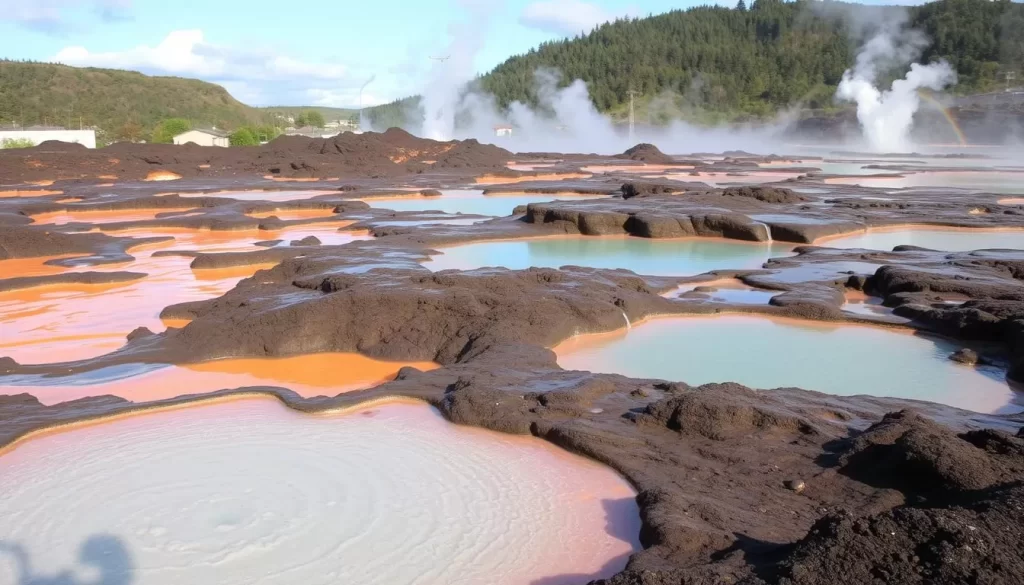
Yanagawa Canal Boat Rides
Yanagawa, often called the “Venice of Kyushu,” offers traditional punted boat rides along its 470 kilometers of canals. Originally built as a castle defense system over 400 years ago, these canals now provide a serene and picturesque experience, with boatmen singing traditional songs as they navigate the waterways.
Arita: Birthplace of Japanese Porcelain
Arita in Saga Prefecture has been producing fine porcelain for over 400 years, since Korean potters brought the technique to Japan in the early 17th century. Visitors can explore the historic kilns, museums, and shops selling this world-renowned ceramics, making Arita a significant cultural destination in Kyushu.
These unique cultural experiences make Kyushu a fascinating place to visit, offering insights into the island’s history, traditions, and natural beauty. Whether you’re exploring the hot springs, enjoying a canal boat ride, or discovering the art of porcelain making, Kyushu is sure to leave a lasting impression.
Kyushu’s Culinary Delights
As you explore Kyushu, you’ll discover a culinary landscape that’s distinct from other Japanese regions. The island’s history as a gateway to foreign cultures, abundant seafood, fertile farmland, and unique culinary traditions have all contributed to its rich gastronomic heritage.
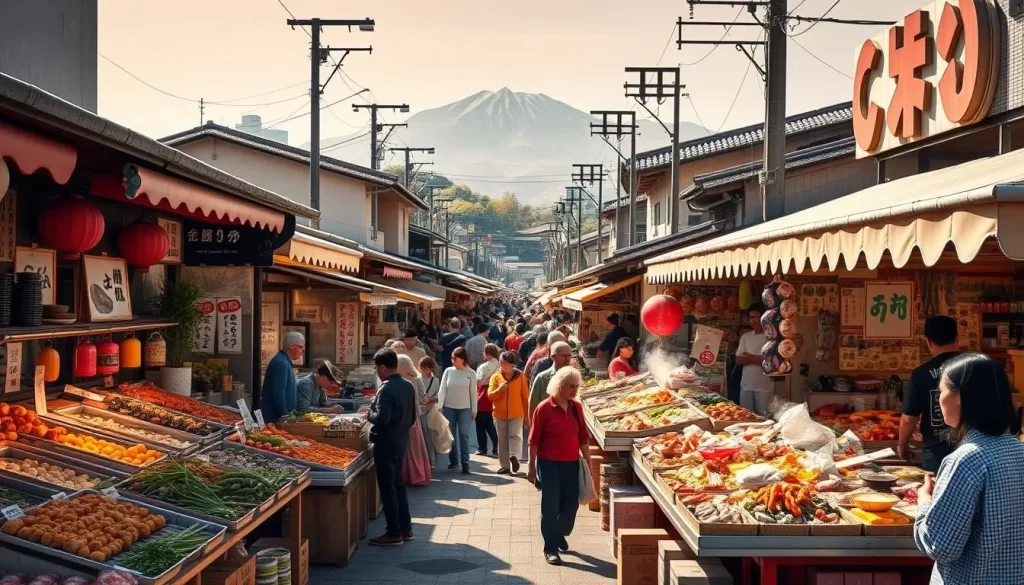
One of the standout features of Kyushu’s cuisine is its emphasis on local ingredients and traditional cooking methods. In Fukuoka city, you can sample the famous Hakata ramen, characterized by its rich, milky tonkotsu broth and thin noodles. This style of ramen has gained international recognition and is a must-try when visiting the city.
Hakata Ramen and Tonkotsu
Hakata ramen is a specialty of Fukuoka, and its popularity has spread throughout the world. The dish is made with a rich tonkotsu broth, which is simmered for hours to extract the flavors from pork bones. You can enjoy this delicious ramen at its most authentic in the yatai stalls of Fukuoka, where locals and visitors gather to savor the flavors.
Another local favorite is motsunabe, a hearty hot pot dish featuring beef or pork offal, cabbage, garlic chives, and other vegetables simmered in a soy sauce or miso-based broth. This comforting dish is perfect for cooler evenings and is best enjoyed with local shochu, a distilled spirit that’s a staple in Kyushu.
Seafood Specialties
Seafood is a highlight throughout coastal Kyushu, with various regions offering their own unique specialties. In Saga, you can try mudskippers, while Nagasaki is famous for its champon noodles loaded with seafood. Kagoshima is renowned for its flying fish, served in various ways, from sashimi to deep-fried. When visiting these coastal towns, be sure to try the local seafood dishes, which showcase the freshness and quality of the ingredients.
Street Food at Yatai Stalls
The yatai food stalls of Fukuoka offer a unique dining experience, where you can sit shoulder-to-shoulder with locals and visitors alike. These small mobile restaurants typically seat 7-8 people and serve a range of dishes, from ramen and oden to grilled skewers and sake. Visiting the yatai stalls is a great way to experience the local food culture, and you can enjoy a meal at any time of day.
As you explore Kyushu, you’ll find that the island’s cuisine is not just about the food, but also about the culture and traditions that surround it. Whether you’re trying local specialties or simply enjoying a meal at a yatai stall, you’re sure to have a memorable culinary experience in this special place.
Where to Stay in Kyushu
Finding the perfect place to stay in Kyushu can enhance your travel experience, with options ranging from traditional ryokans to modern hotels. Kyushu offers a diverse range of accommodations to suit every traveler’s needs, ensuring a comfortable and enjoyable stay.
Best Areas for First-Time Visitors
For first-time visitors, basing yourself in Fukuoka city provides excellent transportation links to other parts of the island. The area around Hakata Station is particularly convenient, offering numerous hotel options and direct access to the Shinkansen.
Staying in Fukuoka city allows you to explore its vibrant atmosphere while having easy access to other destinations on the island. The city’s infrastructure and transportation network make it an ideal base for your Kyushu adventure.
Ryokan Experiences
Staying in a traditional ryokan (Japanese inn) offers an authentic cultural experience with tatami mat rooms, futon bedding, and kaiseki multi-course meals. Many ryokans also feature private or shared onsen baths, particularly in hot spring towns like Kurokawa or Yufuin.
A ryokan stay is a unique opportunity to immerse yourself in Japanese culture and relax in a serene environment. It’s an experience that combines traditional hospitality with natural beauty.
Budget to Luxury Options
Kyushu caters to all budgets with its range of accommodations, from budget-friendly hostels to luxury resorts. In major cities, business hotels like Dormy Inn, APA Hotels, and Toyoko Inn offer good value, often including free public baths.
For a more luxurious experience, consider staying at a high-end ryokan or a specialized accommodation like the Dutch-themed Huis Ten Bosch Hotel in Sasebo. These unique options provide a memorable stay and a chance to experience something different.
Sample Kyushu Itineraries
To truly experience the essence of Kyushu, it’s essential to plan your trip carefully, taking into account the island’s numerous attractions and activities. With a well-planned itinerary, you can make the most of your time and enjoy the diverse experiences that Kyushu has to offer.
7-Day Kyushu Highlights Tour
A 7-day Kyushu highlights tour is an ideal way to explore the island’s most significant attractions. You can start in Fukuoka, spending 2 days exploring the city and visiting Dazaifu. From there, head to Nagasaki, where you can spend 2 days visiting the Peace Park, Dejima, and Mount Inasa. Next, travel to Kumamoto for a day of exploring the castle and Suizenji Garden. Finally, spend 2 days in the Mount Aso/Kurokawa Onsen area, enjoying nature and relaxation.
10-Day Complete Kyushu Experience
For travelers with more time, a 10-day complete Kyushu experience is the perfect way to delve deeper into the island’s culture and natural beauty. You can add Kagoshima to your itinerary, visiting Sakurajima volcano and using it as a gateway to Yakushima. Additionally, you can explore Takachiho Gorge for its mythological significance and natural beauty, and visit Beppu for its unique hot springs and “hells.”
Weekend Getaways from Fukuoka
If you’re short on days, consider a weekend getaway from Fukuoka. You can take a hot spring escape to Yufuin (90 minutes by train), explore the pottery town of Arita and the theme park Huis Ten Bosch (2 hours by train), or visit the castle town of Karatsu (1 hour by train). Renting a car can be beneficial for these trips, especially when visiting areas with limited public transportation.
When planning your travel itinerary, consider using major city as bases for day trips rather than changing accommodations every night. This can save you time and the hassle of frequently moving luggage. Additionally, renting a car is highly recommended for certain itineraries, particularly those including Mount Aso, Takachiho Gorge, and the Kirishima mountains, as these areas have limited public transportation.
| Itinerary | Duration | Key Destinations |
|---|---|---|
| 7-Day Highlights Tour | 7 days | Fukuoka, Nagasaki, Kumamoto, Mount Aso/Kurokawa Onsen |
| 10-Day Complete Experience | 10 days | Fukuoka, Nagasaki, Kumamoto, Kagoshima, Yakushima, Takachiho Gorge, Beppu |
| Weekend Getaway | 2-3 days | Yufuin, Arita, Karatsu |
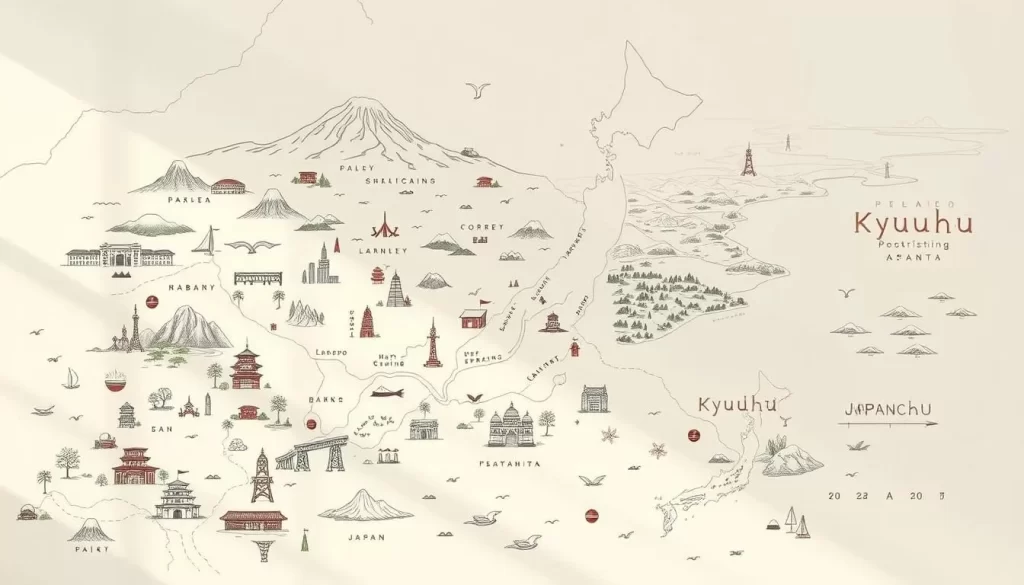
Conclusion: Why Kyushu Should Be Your Next Japanese Adventure
If you’re looking for a travel destination that provides an authentic Japanese experience without the crowds, Kyushu is the perfect choice. This southern island offers a perfect balance of traditional culture, historical landmarks, and natural beauty, catering to diverse interests.
Kyushu’s diverse attractions range from historical sites like Nagasaki and Kumamoto Castle to breathtaking natural landscapes, including volcanic mountains and therapeutic hot springs. The region’s food scene is also a major draw, with specialties like Hakata ramen, fresh seafood, and local shochu providing a culinary journey through Kyushu’s cultural influences.
The warm hospitality of Kyushu locals creates opportunities for genuine cultural exchanges. With excellent transportation options, including the Shinkansen and well-maintained roads for driving a car, Kyushu is accessible for both first-time visitors to Japan and seasoned travelers. Whether you’re planning a dedicated trip to this island or adding it to a broader Japan itinerary, Kyushu promises unforgettable experiences that showcase a different side of Japan.
The above is subject to change.
Check back often to TRAVEL.COM for the latest travel tips and deals.
